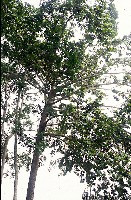| DESCRIPTION: It is an evergreen tree reaching 25-40 m in height and 60-150 cm in trunk diameter, occasionally more, bole straight, cylindrical, without buttresses. Leaves 18-31 x 5-9 cm, usually with the margins nearly parallel, acuminate at apex, cordate at base, leathery. Fruits (often occurring within the flowers) ellipsoid or almost spherical drupe, 2.5-3.8 cm long and 1.9-3.2 cm in diameter, often in dense clusters at the base of the twigs, opening by 2 valves and exposing a solitary black seed with a bright red aril much branched at the apex. USE: Oil is extracted from the seeds and is used in making soap and as an illuminant. The seeds burn like candles. The timber is easily worked, and straight-grained, used for veneer peeling, panels, furniture frames, box-making and minor joinery. Bark decoction is an emeto-purgative and can act as an antidote to poisoning; help treat leprosy and, if pounded, used for stomachic. Sap acts as a syptic (arrests bleeding). Leaf and bark help to relieve toothache. Leaf decoction as a drink or enema for dropsy. Seed fat and probably leaf juice is used in treating thrush. Root infusion acts as an anthelmintic. It is planted as a shade for bananas, coffee and cocoa. GROWING PERIOD: Perennial. COMMON NAMES: African nutmeg. FURTHER INF: It is found in the moist lowland rainforests from West Africa to Uganda and Tanzania. The tree is mainly found in scattered fashion in the secondary formation of evergreen and semi-deciduous forests. When frequent in closed high forest it is usually an indicator of old secondary forest. It does not colonize in quantity but occurs as individuals in forest gaps and clearings. The boundaries of its natural range correspond to its minimum rainfall and a dry season of 3-5 months. |
